As a scientific ideal, we imagine scientists designing studies to test single hypotheses. After all, this is the whole point of controlling variables in an experiment — to test one possible explanation at a time. However, in reality, hypotheses are tested in bundles; there is simply no way to isolate a single idea for testing. Imagine using radiometric dating (based on the decay of uranium-238 into lead-206) to estimate the age of a rock. The test suggests and supports the hypothesis that the rock is 3.8 billion years old. This might seem to be cut-and-dried, but in fact, there are many other hypotheses hidden within this test, including that:
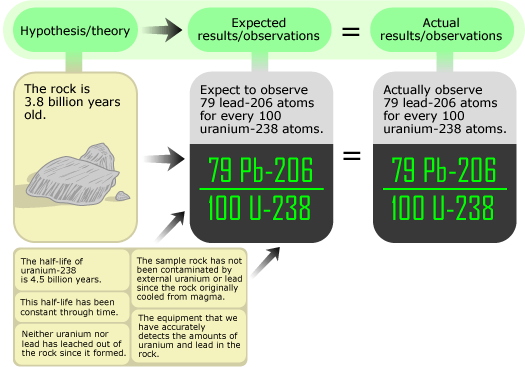
- The half-life of uranium-238 is 4.5 billion years.
- This half-life has been constant through time.
- The sample rock has not been contaminated by external uranium or lead since the rock originally cooled from magma.
- Neither uranium nor lead has leached out of the rock since it formed.
- The equipment that we have accurately detects the amounts of uranium and lead in the rock.
If any one of those hypotheses turns out to be inaccurate, then we have a problem. We could have gotten our test result for a reason other than that the rock is actually 3.8 billion years old. Our test results depend on all of these hypotheses — not just on the actual age of the rock.
Such auxiliary hypotheses are sometimes called assumptions. The assumptions of a particular test are all the hypotheses that are assumed to be accurate in order for the test to work as planned. However, it’s important to recognize that these assumptions are really hypotheses in disguise — ideas which themselves could turn out to be accurate or innaccurate. All tests involve auxiliary hypotheses.
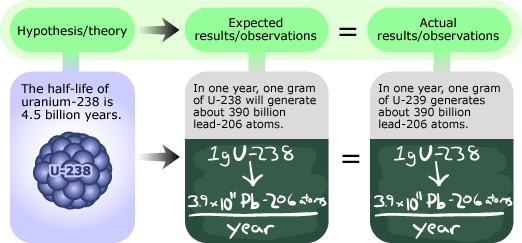 “Now, wait a minute,” you might wonder, “If we can’t ever isolate a single idea for testing — if all tests have auxiliary hypotheses — then how can the process of science ever give us much confidence in any hypothesis?” This is not the problem that it might at first seem. Our auxiliary hypotheses can be checked by independent testing. Many other tests support the ideas that the half-life of uranium-238 is 4.5 billion years, that this decay rate is constant, etc. Because those auxiliary hypotheses seem to be pretty accurate based on our other tests, we can have confidence that, in this test, our results really do support the idea that the rock is 3.8 billion years old.
“Now, wait a minute,” you might wonder, “If we can’t ever isolate a single idea for testing — if all tests have auxiliary hypotheses — then how can the process of science ever give us much confidence in any hypothesis?” This is not the problem that it might at first seem. Our auxiliary hypotheses can be checked by independent testing. Many other tests support the ideas that the half-life of uranium-238 is 4.5 billion years, that this decay rate is constant, etc. Because those auxiliary hypotheses seem to be pretty accurate based on our other tests, we can have confidence that, in this test, our results really do support the idea that the rock is 3.8 billion years old.
Through continued testing of different groupings of hypotheses, the process of science can home in on the accuracy of individual hypotheses. Nevertheless, when examining the results of a particular test, it is important to recognize all of the auxiliary hypotheses that a test depends upon. The history of heliocentrism (the idea of a sun-centered solar system) illustrates how incorrect auxiliary hypotheses have led to incorrect conclusions.
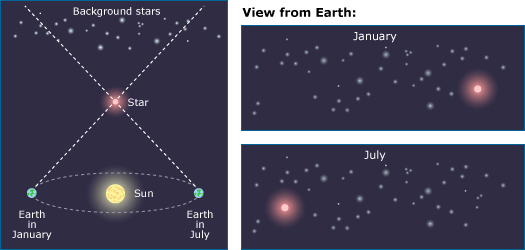 In 1543, Nicolaus Copernicus proposed the then revolutionary idea that the Earth orbits the sun instead of the other way around. With modern observational equipment, this seems patently obvious, but in the 16th century it was not. One way to test the idea was to search for parallax — the apparent shift in the relative position of objects based on the position of the observer. Demonstrating parallax is easy: hold a pencil vertically at arms length. Cover one eye to look at the pencil with just your right eye and then just your left eye. As you do this, the pencil will seem to jump back and forth relative to the background. Copernicus’ contemporaries reasoned that if the Earth were really moving around the sun, it would also be moving with respect to the stars — and so we should observe a stellar parallax. In other words, the view of the stars from one extreme of Earth’s orbit (e.g., the view during the summer solstice) should be a bit like looking at the pencil with your right eye, and the other extreme (e.g., the winter solstice) should be like the view with your left eye: just as the apparent positioning of the pencil and the background objects shift relative to one another, so too should the apparent positioning of near and far stars. If the Earth were really orbiting the sun, the constellations should look different in the summer (one extreme of the Earth’s orbit) than they do in the winter (the other extreme).
In 1543, Nicolaus Copernicus proposed the then revolutionary idea that the Earth orbits the sun instead of the other way around. With modern observational equipment, this seems patently obvious, but in the 16th century it was not. One way to test the idea was to search for parallax — the apparent shift in the relative position of objects based on the position of the observer. Demonstrating parallax is easy: hold a pencil vertically at arms length. Cover one eye to look at the pencil with just your right eye and then just your left eye. As you do this, the pencil will seem to jump back and forth relative to the background. Copernicus’ contemporaries reasoned that if the Earth were really moving around the sun, it would also be moving with respect to the stars — and so we should observe a stellar parallax. In other words, the view of the stars from one extreme of Earth’s orbit (e.g., the view during the summer solstice) should be a bit like looking at the pencil with your right eye, and the other extreme (e.g., the winter solstice) should be like the view with your left eye: just as the apparent positioning of the pencil and the background objects shift relative to one another, so too should the apparent positioning of near and far stars. If the Earth were really orbiting the sun, the constellations should look different in the summer (one extreme of the Earth’s orbit) than they do in the winter (the other extreme).
Copernicus’ peers and astronomers who came after him looked for this parallax, but found none. The positions of the stars relative to one another seemed to be the same, no matter the time of year. Copernicus’ idea was rejected by astronomers of the day for this and many other reasons. So, what went wrong? The astronomers had performed the right test (looking for parallax), but little did they know that two of their auxiliary hypotheses were inaccurate. The astronomers had assumed that:
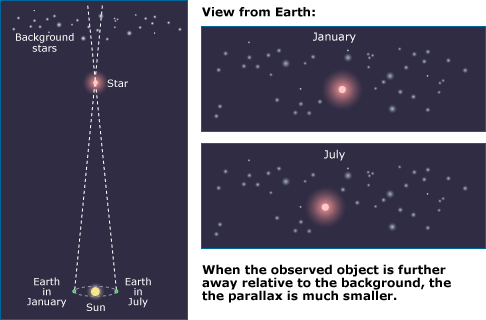
- The stars are not that far away. When the observer is relatively close to the observed objects, the observed parallax is large and obvious. But when the observed objects are relatively far away, the parallax is smaller. You can demonstrate this for yourself. Go outside and look for two far-off objects — perhaps two distant trees. Cover your right eye and then your left, as you did for the pencil. You won’t notice much change in the appearance of the trees, though you noticed a big change in the appearance of the pencil and background objects. The astronomers had assumed that the stars are relatively close to the Earth and hence, that the parallax would be obvious. But in fact, the stars are quite distant — after our own sun, the nearest star is more than 24 trillion miles away!1 The stars actually do exhibit parallax — but they are so far away that it is tiny.
- Their observational tools were sensitive enough to detect parallax. The astronomers had assumed that if the parallax was there, they’d be able to observe it. But the stellar parallax from Earth is so small, that it is only with extremely sensitive, 21st century equipment that we are able to detect it!2
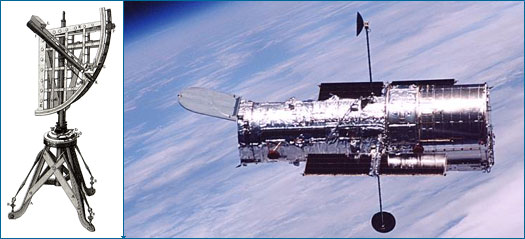
Because these two hypotheses turned out to be false, 16th century astronomers came to the wrong conclusion about the parallax test. They saw their test results as strong evidence that Earth does not orbit the sun, but in fact, with the right equipment, the parallax test (along with many others) suggests that Copernicus was right — the Earth orbits the sun!
- Need a quick review of radiometric dating? Check out PBS’s video or the US Geological Survey’s reader on the topic.
- To learn more about how technology advances the process of science, visit Science and technology on fast forward in What has science done for you lately?
1http://www.nasa.gov/centers/goddard/news/topstory/2003/0520newstar.html
2Oreskes, N. 2003. The role of quantitative models in science. Pp. 13-31 in Charles D. Canham, Jonathan J. Cole, and William K. Lauenroth (eds.). Models in Ecosystem Science. Princeton University Press, Princeton.
